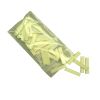YSI 6136 Turbidity Sensor
The YSI 6136 Turbidity Sensor provides accurate, in-situ measurement of turbidity in fresh, brackish, and salt water, as well as other applications that require highly accurate turbidity data.
Features
- Temperature compensation provides greater accuracy
- Wiped optics field-proven for fouling prevention
- Compatibility with all YSI optical port sondes provides system flexibility
- Expedited repair and warranty service
- Lifetime technical support
- More
Overview
The YSI 6136 Turbidity Probe is a fouling-resistant, wiped sensor designed to seamlessly integrate with all YSI sondes that contain an optical port using no external software. The YSI 6136 provides accurate, in situ measurement of turbidity in fresh, brackish, and salt water environments, as well as other applications requiring highly accurate turbidity data.
Pairable
The YSI 6136 sensor can be used in combination with YSI sondes that have optical ports - 600 OMS, 6820, 6920, 6600, or 6600 EDS (Extended Deployment System) - and a YSI 650 MDS handheld display-logger. Make surface as well as vertical profile measurements. In addition, the YSI 6136, in combination with one of the YSI data-logging sondes, can be used for unattended continuous monitoring or integrated with data collection platforms for real-time data acquisition.
- Range: 0 to 1000 NTU
- Resolution: 0.1 NTU
- Accuracy: +/-2% of reading or 0.3 NTU, whichever is greater
- Warranty: 2 years
In The News
Dredging found to reduce fish biodiversity
Researchers at Penn State University find that dredging projects may reduce fish diversity, according to a release. Dredging is usually undertaken to remove detrimental sediment from a waterway. The investigators looked at 15 sites along the Allegheny River in Pennsylvania, comparing sections that had been dredged to undredged ones. They found reduced fish populations and less variety in aquatic life in areas where dredging occurred. The researchers say the dredging process increases turbidity, which alters fish-foraging ability. High sedimentation can also affect spawning, so species that are tolerant come to dominate ecosystems in which dredging took place. Image: A clamshell dredge in action (Credit: U.S.
Read MoreTwo autonomous underwater vehicles launch in Lake Ontario
Two autonomous underwater vehicles are drifting through Lake Ontario, monitoring a slew of environmental metrics, according to a release from New York Sea Grant. The high-tech equipment is recording data on fish productivity, food web changes and algae levels. Each AUV weighs 42 pounds, is six and a half feet long and has a slew of sensors, including side scan sonar and 10-beam Doppler. Mapping capability complements collected parameters like temperature, turbidity, pH and levels of oxygen and phosphorus, among others. The research is made possible through the Cooperative Science Monitoring Initiative between the US and Canada called for under the Clean Water Act of 1972.
Read MoreSensors to help sort out Storm Lake's sediment issues in Iowa
Wind probably isn’t the first thing that people think of when considering causes of poor water quality, but sediment disturbances caused by the combination of shallow waters and high winds are threatening the health of Iowa’s Storm Lake. Although Storm Lake looks picturesque from a distance, the resuspension of sediment is affecting water clarity and exposing harmful nutrients in the water. Led by Clayton Williams and John Downing, professors in Iowa State University’s Department of Ecology, Evolution and Organismal Biology, a research team has begun monitoring the lake to determine the causes and potential solutions to the lake’s sediment issues.
Read More















